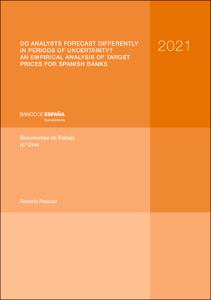Do analysts forecast differently in periods of uncertainty? An empirical analysis of target prices for Spanish banks
Autor
Fecha de publicación
16-dic-2021
Descripción física
48 p.
Resumen
Los precios objetivo son una estimación del valor futuro de la cotización de una empresa. Aunque hay un consenso general sobre la importancia de los fundamentales de las empresas a la hora de hacer previsiones, existen también otros determinantes. Este documento explica los efectos de la incertidumbre, el estrés financiero y la volatilidad sobre las estimaciones del precio objetivo. Para ello, se elaboran varios indicadores para las ocho principales entidades financieras españolas desde 1999 hasta 2020. Estos muestran que, en promedio, los analistas tienen un sesgo optimista en sus valoraciones y tienden a reaccionar con retardo a los movimientos de las acciones. Las diferentes medidas de incertidumbre, estrés financiero y volatilidad afectan a sus estimaciones: a) fomentando el sesgo optimista; b) reduciendo la velocidad y c) la voluntad de ajuste a los movimientos del precio de las acciones, y d) haciendo que confíen menos en estos últimos como indicadores de los fundamentales de los bancos. Estos efectos se ven reforzados por el método de agregación del precio objetivo compuesto (en concreto, por el papel de antigüedad de las contribuciones individuales). Ambos factores actúan en tándem: cuanto más incierto sea el entorno económico y financiero, menos probable será que los precios objetivos agregados se muevan en función de las cotizaciones bursátiles, ya que las contribuciones individuales más antiguas ralentizarán el proceso de ajuste. Un simple cambio en el método de agregación reduce su impacto en los indicadores, sin alterar sustancialmente sus conclusiones.
Target prices are an estimation of the future value of a company’s stock price. Although there is a general consensus about the importance of firm’s fundamentals when forecasting, there are also other determinants. This article sheds light on the effects of uncertainty, financial stress and volatility on target price estimations. To do so, different indicators are elaborated for the eight main Spanish financial entities from 1999 to 2020. They show that, on average, analysts have an optimistic bias in their valuations, and tend to react with a delay to stock movements. The different measures of uncertainty, financial stress and volatility affect their estimations a) fostering the optimistic bias, b) reducing the speed and c) willingness of the adjustment to share price movements, and d) make them trust less on stock prices as indicators of banks’ fundamentals. This effects are reinforced by the aggregation method of the composite target price (in particular the role of the older individual contributions). Both factors work in tandem: as the more uncertain the economic and financial environment is, the less likely aggregate target prices would move according to stock prices, because older individual contributions will slow the adjustment process. A simple change in the aggregation method reduces its impact on the indicators, without substantially altering their conclusions.
Target prices are an estimation of the future value of a company’s stock price. Although there is a general consensus about the importance of firm’s fundamentals when forecasting, there are also other determinants. This article sheds light on the effects of uncertainty, financial stress and volatility on target price estimations. To do so, different indicators are elaborated for the eight main Spanish financial entities from 1999 to 2020. They show that, on average, analysts have an optimistic bias in their valuations, and tend to react with a delay to stock movements. The different measures of uncertainty, financial stress and volatility affect their estimations a) fostering the optimistic bias, b) reducing the speed and c) willingness of the adjustment to share price movements, and d) make them trust less on stock prices as indicators of banks’ fundamentals. This effects are reinforced by the aggregation method of the composite target price (in particular the role of the older individual contributions). Both factors work in tandem: as the more uncertain the economic and financial environment is, the less likely aggregate target prices would move according to stock prices, because older individual contributions will slow the adjustment process. A simple change in the aggregation method reduces its impact on the indicators, without substantially altering their conclusions.
Publicado en
Documentos de Trabajo / Banco de España, 2144
Materias
Precio objetivo; Estimaciones de analistas; Analista financiero; Sesgos de analistas; Incertidumbre; Target price; Analyst forecast; Financial analyst; Analyst bias; Uncertainty; Regulación y supervisión de instituciones financieras; Mercados de valores; Instituciones crediticias de depósito; España
Aparece en las colecciones:












